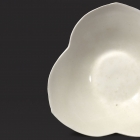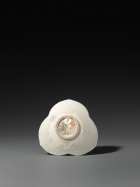J.J. Lally & Co., Oriental Art / New York City, New York
MenuPast Exhibition
EARLY CHINESE WHITE WARES
The Ronald W. Longsdorf Collection
September 11 - October 3, 2015
13.
A TREFOIL DISH
Five Dynasties-Early Northern Song Dynasty, A.D. 10th Century
Ding kilns
with gently rounded flaring sides formed by three wide petal-shaped lobes rising from a plain recessed medallion in the center, covered inside and out with a transparent glaze of pale ivory tone, showing characteristic ‘tear marks’ where the glaze pools on the underside, the glaze ending unevenly short of the wide ring foot with shallow straight sides enclosing an inset flat base left unglazed revealing the fine white porcelain.
Diameter 4 3⁄4 inches (12 cm)
From the Collection of Carl Kempe (1884-1967), Ekolsund, Sweden
Ex C.T. Loo (1880-1957), no. 80659
This dish has been shown in several museum exhibitions including Mostra d’Arte Cinese (Exhibition of Chinese Art), Palazzo Ducale, Venice, 1954, no. 352; The Arts of the T’ang Dynasty, The Oriental Ceramic Society, London, 1955, no. 202; and Chinese Gold, Silver and Porcelain: The Kempe Collection, Asia House Gallery, New York, 1971, p. 103, no. 102.
This dish also has been published in many scholarly monographs including Lindberg, “Hsing-yao and Ting-yao: An Investigation and Description of Some Chinese T’ang and Sung White Porcelain in the Carl Kempe and Gustaf Lindberg Collections,” B.M.F.E.A., Bulletin No. 25, Stockholm, 1953, pl. 34, fig. 28; Gyllensvärd, Chinese Ceramics in the Carl Kempe Collection, Stockholm, 1964, no. 356; and Gyllensvärd, “A Botanical Excursion in the Kempe Collection,” B.M.F.E.A., Bulletin No. 37, Stockholm, 1965, no. 20.
A very similar trefoil dish unearthed in 1956 from the tomb of Madam Zhao Siqian at Haizhou, Yudai river, Xinhailian city, Jiangsu province, dated by epitaph to the fifth year of Dahe (corresponding to A.D. 933) in the Wu Kingdom, is illustrated in Zhongguo taoci quanji (The Complete Works of Chinese Ceramics), Vol. 6: Tang, Five Dynasties, Shanghai, 2000, no. 215. A number of Dingyao trefoil dishes were unearthed in 1985 from the cache attributed to the late Tang dynasty discovered at Huoshaobi village, in the northern suburbs of Xi’an, Shaanxi province. One dish from the group, bearing a ‘guan’ mark incised on the base, is illustrated in Dingci ya ji: Gugong bowuyuan zhencang ji chutu Dingyao ciqi huicui (Selection of Ding Ware: the Palace Museum’s Collection and Archaeological Excavation), Beijing, 2012, pp. 40-41, no. 6.
Compare also the Dingyao white porcelain trefoil dish of closely related form in the Percival David Foundation of Chinese Art, which was included in the International Exhibition of Chinese Art at the Royal Academy of Arts, London, 1935-36, no. 1179 and published by Scott, Imperial Taste: Chinese Ceramics from the Percival David Foundation, Los Angeles, 1989, p. 24, no. 4.
According to Gyllensvärd in his discussion “A Botanical Excursion in the Kempe Collection,” op. cit., the unique trefoil form may refer to the plant trillium (yanling cao in Chinese).
五代-北宋初年 定窰白瓷三尖瓣口碟 徑 12 厘米

